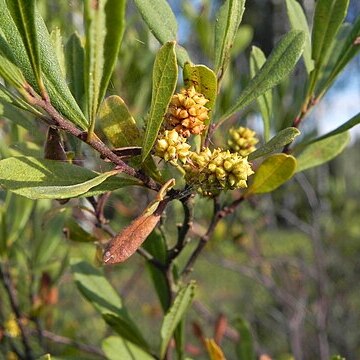Trees or erect shrubs, often dotted with yellow glands and strongly aromatic. Leaves spirally arranged, exstipulate, or stipulate in young plants only, shortly petioled, simple, entire, serrate-dentate or more or less deeply pinnatisect, penni-nerved. Flowers in axillary, solitary or spiked or racemed catkins, (♂)(♀) or (♂♀); when the inflorescence is (♂♀), then the ♂ flowers below the ♀; each flower subtended by a bract. Sepals and petals absent, or the ♀ with 2 or more minute sepaloid bracteoles. ♂: Stamens 2-20, usually 2-4; filaments free or more or less connate into a column; anthers erect, 2-celled; cells opening by longitudinal slits. Rudimentary ovary, as a rule, absent. Female: no staminodes. Ovary sessile, 1-celled. Style deeply bifid; branches short or longish, stigmatose on the inner side. Ovule 1, basal, erect, orthotropous. Drupe ovoid, ellipsoid or globose, tuberculate; endocarp hard. Seed erect, not comose; testa membranous; endosperm none; embryo straight; cotyledons plano-convex; radicle short.
Trees or shrubs evergreen or deciduous, dioecious or monoecious, with resinous, peltate glands in young parts. Leaves simple, often aggregated at apex of shoot, margin entire or serrate; stipules absent. Flowering precocious or coetaneous. Inflorescences spicate, simple or paniculate. Male flowers with 2-8(-20) stamens; filaments free or united at base, with bracteoles or not. Female flowers with 2-4 bracteoles adnate to ovary and enlarged, or free and not enlarged; ovary with resinous glands; style short, with 2 relatively long stigmatic branches. Fruit a drupe, often with headlike, wax-covered papillae; endocarp hard. Seeds erect, with membranous testa.
Monoecious or dioecious shrubs or small trees. Leaves simple, alternate, often glandular below, generally fragrant; estipulate. Inflorescence spicate, axillary. Flowers small, achlamydeous, bracteate, sometimes also bracteolate. Staminate flowers with 2-30 stamens, the filaments free or connate, the anthers longitudinally dehiscent. Pistillate flowers 2-carpellate, the ovary 1-locular, the ovule 1, ortho-tropous, the stigmas 2, filiform. Fruit a small drupe with a wax-secreting exocarp, often warty; embryo straight, surrounded by a 1-layered oily endosperm, the cotyledons thick, plano-convex.
Pistillate fl subtended by a primary bract and 2–6 bracteoles, the latter persistent or deciduous, often resembling tiny sep, not forming a bur; ovary glabrous, or often covered with waxy papillae, sometimes also hairy, ripening into an achene or drupelet; aromatic shrubs or small trees, ours all dioecious, with entire or merely toothed, exstipulate lvs. (Cerothamnus, Gale, Morella) Spp. 2–4 are closely related and not always sharply distinct. Nearly 50, widespread

